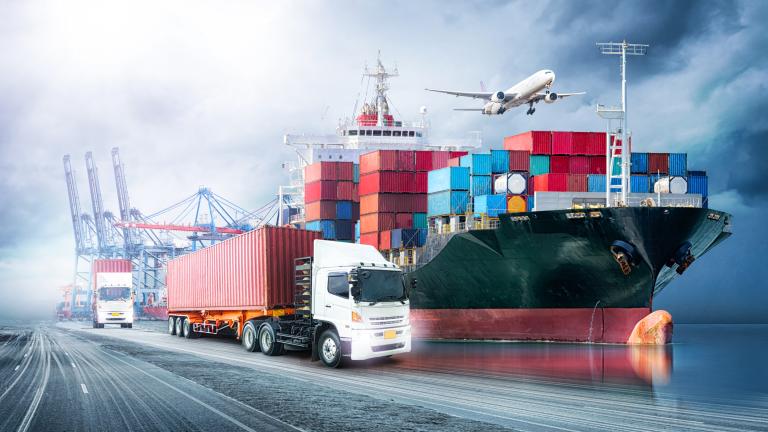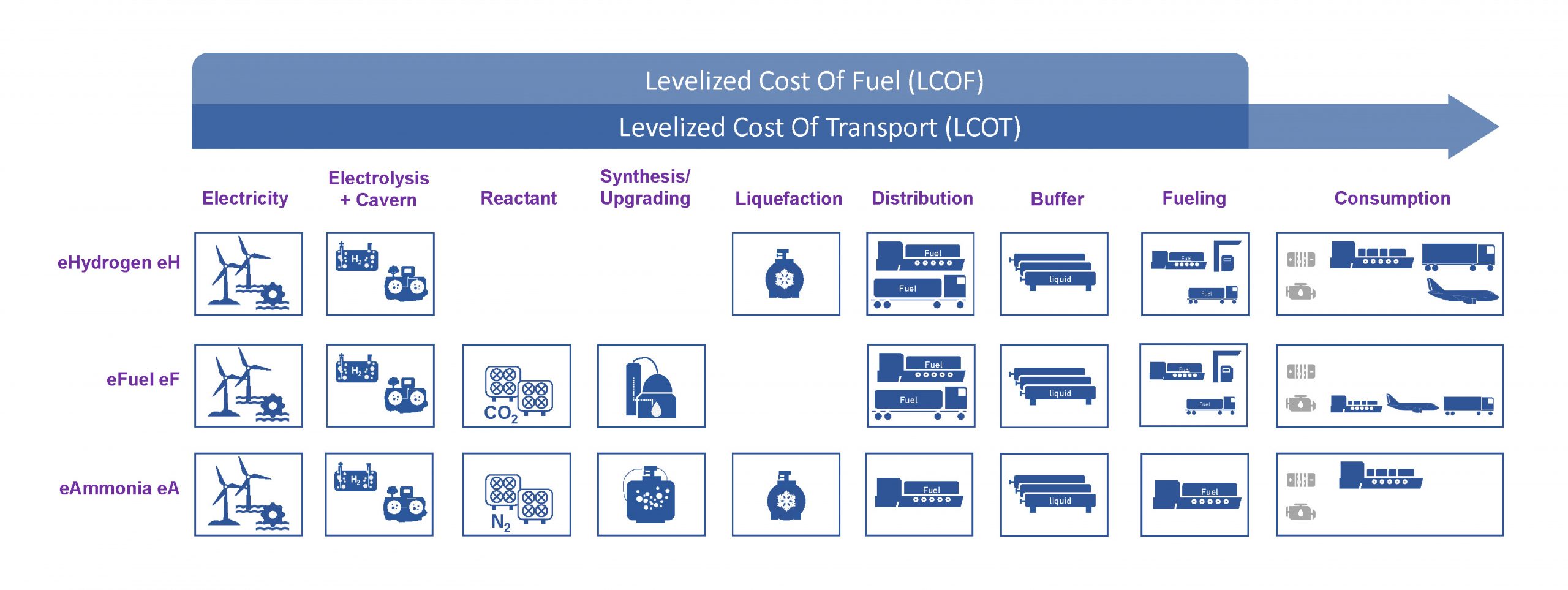
Achieving net zero emissions by 2050 represents a significant challenge for the global trucking, shipping and aviation sectors. Unlike the continuous improvements in battery storage technology for passenger and light-duty vehicles only fossil fuels meet the considerable technical and economic requirements of most truck, ship and plane traffic as of today. Hence with the regulatory banishment of greenhouse gas emissions, there is widespread interest in using sustainable hydrogen fuels. Produced from renewable energy sources, water, and optionally carbon dioxide or nitrogen captured from the atmosphere, the respective fuels are hydrogen (eHydrogen), hydrocarbon fuels (eFuel) and ammonia (eAmmonia); where the e stands for renewable, electricity-based fuels. eFuel can be used in existing combustion engines, whereas eHydrogen and eAmmonia depend on electrochemical conversion in fuel cells or adjustments in combustion engines and fuel tanks. The most promising technical fuel pathways are eHydrogen and eFuel for long-haul trucking, eHydrogen, eFuel and eAmmonia for short-sea shipping and eHydrogen and eFuel for short-haul aviation as shown in Figure 1.

Figure 1. Three value chains of fuel supply and consumption.
Adjusting the dynamic cost model to account for different sources of sustainable electricity generation, fuel production and distribution obtains the levelized cost of fuel (LCOF) and the levelized cost of transport (LCOT) for the trucking, shipping and aviation.
Previous studies investigate the value chains (Figure 1) with regard to the eHydrogen, eAmmonia and eFuel costs, costs of decarbonizing trucking, shipping and aviation, and the technical usability of alternative fuels in the transport sectors. While these studies rely on various sources of external fuel costs or focus on one mode, a reliable cost comparability of fuels and transport modes only occurs with uniform assumptions of the value chains’ horizontal and vertical dimensions.
To understand the economic changes while decarbonizing long-haul trucking, short-sea shipping and short-haul aviation until 2050, this paper describes a new dynamic cost model. Its 140 parameters can be tailored to local conditions with reference to renewable electricity generation (onshore wind, offshore wind, hydropower), fuel production, fuel distribution and the use in the trucking, shipping and aviation sectors. We apply the model to Norway, which has excellent renewable energy potential and is considered an early adopter of sustainable transport. The value chains are modelled for the alternative fuels, eHydrogen, eFuel and eAmmonia as illustrated in Figure 1.
To compare fuel and transport alternatives, we apply the concept of levelized cost of energy, which conventionally assigns a power plant’s total lifecycle cost to one unit of energy output. Total lifecycle cost includes capital costs, fuel costs, fixed and variable operations and maintenance costs, financing costs, and a utilization rate. We generalize the approach to calculate levelized cost of all process steps in the value chains, carrying out a detailed bottom-up analysis. Cost data and learning curves are compiled and evaluated in five-year increments from 2020 to 2050 based on publicly available data from articles in peer-reviewed scientific journals and frequently cited reports by consultants, agencies and industry experts, validated by practitioners. Several technologies face uncertainties in our cost estimations, so we implement a range of cost values to investigate the model’s sensitivity in a best- and worst-case scenario. To adjust our model to freight transport, we collect further mode-specific cost data to deliver cargo via trucking, shipping and aviation. Taxes and subsidies for fossil and sustainable alternatives are neglected.
 |
Considering onshore wind power as potentially low-cost, we find that the three transport modes will suffer cost disadvantages when using sustainable hydrogen fuels compared to fossil fuels (Figure 2). For decarbonization, the results reveal the most favorable fuel choices for the investigated transport applications: eHydrogen for long-haul trucking, eFuel in the early years and eAmmonia starting in 2030 for short-sea shipping, and eFuel for short-haul aviation. The existing cost rankings are maintained over the time period: shipping remains the cheapest, whereas aviation is the most expensive transport mode. Compared to current fossil-based transport without government intervention, shipping has the strongest transport cost sensitivity (+232%, 2020; +41%, 2050), followed by aviation (+138%, 2020; +36%, 2050) and trucking (+66%, 2020; +8%, 2050). Lower costs of electricity depending on the choice of renewable electricity generation (e.g. hydropower) significantly affects the levelized cost of transport. eFuel reacts most to lower electricity costs, due to the multiplicative effect of efficiency losses in production and consumption. Offshore wind creates the highest cost of transport. We conclude that by betting on learning curves and substantial cost decreases of technologies needed along the value chain, heavy-duty transport decarbonization by 2050 cannot be achieved. Although the cost gaps to fossil-based transport decrease over time, we see that decarbonization pathways for heavy-duty transport are out of reach without government intervention. Future research is needed to identify optimal public and private support throughout the value chains. Evaluating asymmetric changes in transport costs and its implication on modal shift is another important research topic. |
Figure 2. Change of levelized cost of transport in percentages for aviation, trucking and shipping (grouped from top) considering fuel options based on electricity from onshore wind. Transport costs within and across modes change asymmetrically over time. Percentages show the cost gap of alternatives (base-case) benchmarked to the sector-specific fossil fuel case. Shadows show the maximum uncertainties of fuel costs and vehicle technologies (fossil fuel uncertainty represents the historical cost fluctuation). All shown costs without taxes and subsidies.
References
Martin J., Neumann A., Ødegård A. (2022) “Sustainable Hydrogen Fuels versus Fossil Fuels for Trucking, Shipping and Aviation: A Dynamic Cost Model,” MIT CEEPR Working Paper 2022-010, July 2022.
Further Reading:
CEEPR WP 2022-010
About The Authors
 |
Jonas Martin is a PhD candidate at the Norwegian University of Science and Technology in the Department of Industrial Economics and Technology Management. He holds a Master’s degree in Industrial Engineering Energy Management from the European University of Flensburg. Before starting his doctoral studies in 2020, he worked with transport and energy companies. He was part of the R&D projects Energiepark Mainz by Stadtwerke Mainz operating the world’s first PEM electrolyzer with a size of 6 MW and XEMU by Siemens Mobility developing a modular approach for fuel cell and battery based regional trains. In his PhD project he examines when, where and how sustainable hydrogen fuels will enter the transport markets for trucking, shipping and aviation from a techno-economic and policy perspective. |
 |
Anne Neumann is a full professor at the Department of Industrial Economics and Technology at NTNU and Director of Research for NTNU’s Energy Transition Initiative (NETI) and a Research Affiliate of MIT CEEPR. Her research experience of 15+ years draws on industrial organization, competition economics and econometrics and has provided academic as well as policy relevant publications and advice. From 2014 until 2018 she served as Vice-President for Publications in the International Association for Energy Economics (IAEE; The Energy Journal), is currently Editor for Energy Policy and on the Editorial Board of Economics of Energy and Environmental Policy. She has international teaching experience, (co-) supervised PhD students from several universities and developed research agendas across disciplines. She studied economics at the European University Viadrina in Frankfurt/Oder and holds a PhD in economics from TU Dresden. |
 |
Anders Ødegård is a Senior Project Manager at SINTEF in Norway. He belongs to the Department Sustainable Energy Technology, which focuses on batteries, PV, hydrogen, fuel cells and electrolyzers, covering the whole value chains from materials development up to large scale pilot projects. He has a Master’s degree in electrochemistry from the Norwegian University of Science and Technology, Trondheim, and thereafter spent almost 5 years at Fraunhofer ISE in Freiburg researching fuel cells and obtained his PhD degree. Currently Anders Ødegård coordinates two large European projects on demonstration of PEM electrolyzers at Shell’s Energy and chemicals park in Cologne, the REFHYNE projects. A 10 MW electrolyzer is in operation, while a 100 MW is to be set in operation in 2024. He is also engaged in hydrogen safety research, piloting of hydrogen trucks and establishing hydrogen hubs in Norway. |





